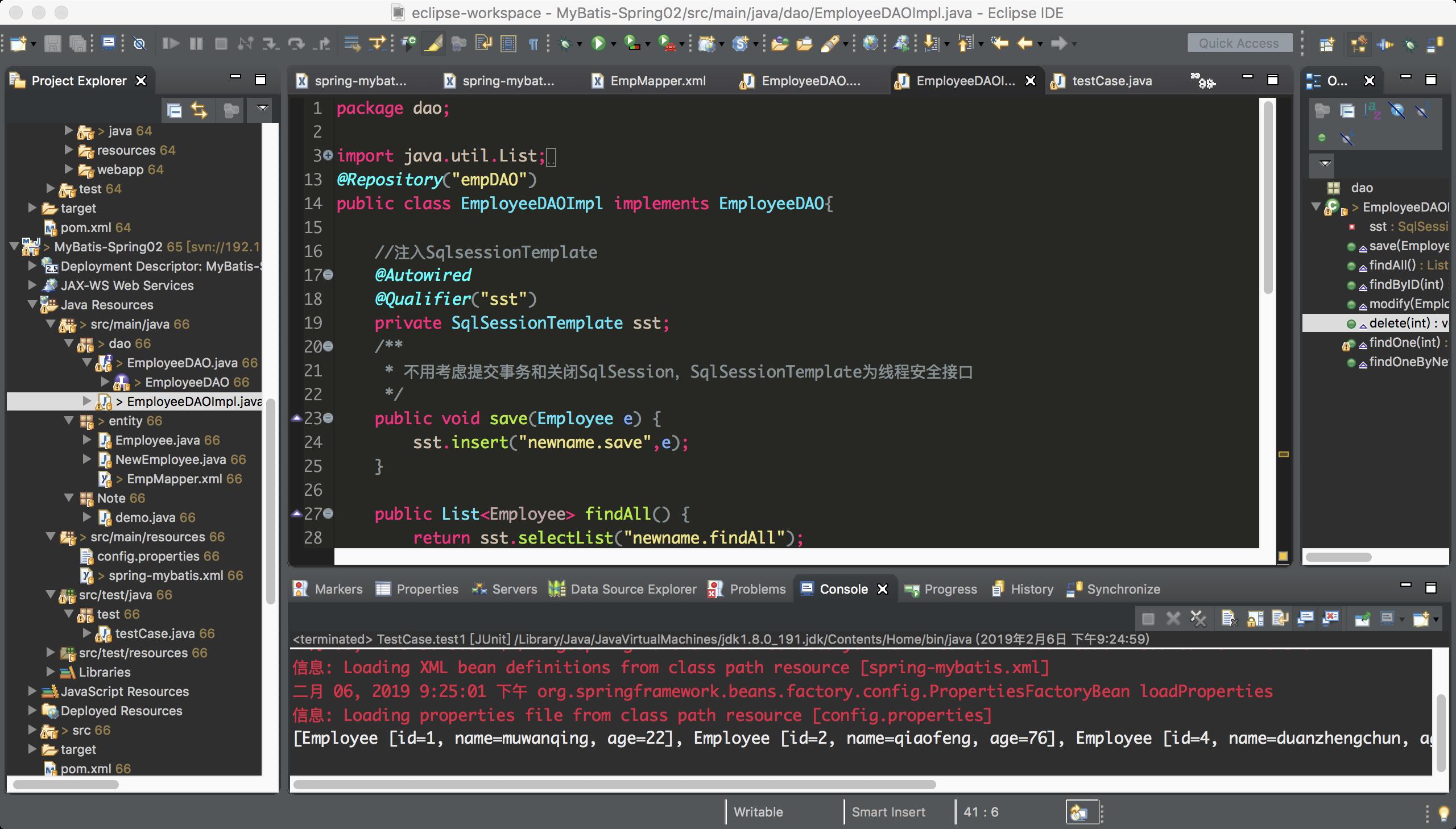Spring集成MyBatis的使用-使用SqlSessionTemplate
Posted 斐波那切
tags:
篇首语:本文由小常识网(cha138.com)小编为大家整理,主要介绍了Spring集成MyBatis的使用-使用SqlSessionTemplate相关的知识,希望对你有一定的参考价值。
Spring集成MyBatis的使用
Spring集成MyBatis,早期是使用SqlSessionTemplate,当时并没有用Mapper映射器,既然是早期,当然跟使用Mapper映射器是存在一些区别的,比如映射文件命名空间不需要跟接口名一样,接口中的方法不一定跟sql的id一样,通过它的SqlSessionTemplate的使用,在具体实现类中可以实现找到对应的sql
Spring-Mybatis集成方式二-使用SqlSessionTemplate
step1 导包:spring-webmvc,mybatis,mybatis-spring,dbcp,ojdbc,spring-jdbc,junit
同Mapper映射器中的配置方式
step2 添加Spring配置文件,不再需要Mybatis的配置文件,可以在Spring配置文件中,添加SqlSessionFactoryBean来代替,且不需要配置MapperScannerConfigurer,而是配置SqlSessionTemplate
<?xml version="1.0" encoding="UTF-8"?> <beans xmlns="http://www.springframework.org/schema/beans" xmlns:xsi="http://www.w3.org/2001/XMLSchema-instance" xmlns:context="http://www.springframework.org/schema/context" xmlns:util="http://www.springframework.org/schema/util" xmlns:jee="http://www.springframework.org /schema/jee" xmlns:tx="http://www.springframework.org/schema/tx" xmlns:jpa="http://www.springframework.org/schema/data/jpa" xmlns:mvc="http://www.springframework.org/schema/mvc" xsi:schemaLocation=" http://www.springframework.org/schema/beans http://www.springframework.org/schema/beans/spring-beans-3.2.xsd http://www.springframework.org/schema/context http://www.springframework.org/schema/context/spring-context-3.2.xsd http://www.springframework.org/schema/util http://www.springframework.org/schema/util/spring-util-3.2.xsd http://www.springframework.org/schema/jee http://www.springframework.org/schema/jee/spring-jee-3.2.xsd http://www.springframework.org/schema/tx http://www.springframework.org/schema/tx/spring-tx-3.2.xsd http://www.springframework.org/schema/data/jpa http://www.springframework.org/schema/data/jpa/spring-jpa-1.3.xsd http://www.springframework.org/schema/mvc http://www.springframework.org/schema/mvc/spring-mvc-3.2.xsd"> <!-- 配置连接池 --> <!-- 读取属性文件 --> <util:properties id="db" location="classpath:config.properties"> </util:properties> <!-- 配置连接池,可以参考DBUtil的方法,这里采用spring创建连接池--> <!-- destroy-method方法作用是:当spring容器关闭后,会将连接释放回到连接池,避免资源浪费 --> <bean id="ds" class="org.apache.commons.dbcp.BasicDataSource" destroy-method="close"> <property name="driverClassName" value="#{db.driver}"/> <property name="url" value="#{db.url}" /> <property name="username" value="#{db.user}" /> <property name="password" value="#{db.pwd}" /> </bean> <!-- 配置SqlSessionFactoryBean --> <bean id="ssfb" class="org.mybatis.spring.SqlSessionFactoryBean"> <!-- 指定连接资源 --> <property name="dataSource" ref="ds"/> <!-- 指定映射文件:entity包下的所有后缀xml的映射文件 --> <property name="mapperLocations" value="classpath:entity/*.xml"/> </bean> <!-- 配置SqlSessionTemplate --> <bean id="sst" class="org.mybatis.spring.SqlSessionTemplate"> <!-- 采用构造器方式注入SqlSessionFactoryBean,注入第一个参数 --> <constructor-arg index="0" ref="ssfb"></constructor-arg> </bean> <!-- 配置组件扫描 --> <context:component-scan base-package="dao"></context:component-scan> </beans>
step3 写实体类,属性名和表格的字段名一样
同Mapper映射器中的配置方式
step4 EmpMapper.xml映射文件,namespace不再要求等同接口名,可以随便取,如取名newname,后续将在具体实现类中使用
<?xml version="1.0" encoding="UTF-8"?> <!DOCTYPE mapper PUBLIC "-//mybatis.org//DTD Mapper 3.0//EN" "http://mybatis.org/dtd/mybatis-3-mapper.dtd"> <mapper namespace="newname"><!-- 如果不是采用Mapper映射器,命名空间随便写,不做要求 --> <!-- id要求唯一 parameterType:填写实体类的完整名字 --> <!-- 插入语句 --> <insert id="save" parameterType="entity.Employee"> INSERT INTO T_TABLE VALUES(6,#{name},#{age}) </insert> <!-- 根据id查询语句 --> <select id="findByID" parameterType="int" resultType="entity.Employee"> SELECT * FROM T_TABLE WHERE ID=#{id} </select> <!-- 查询所有结果,不需要参数类型 --> <select id="findAll" resultType="entity.Employee"> SELECT * FROM T_TABLE </select> <!-- 修改操作 --> <update id="modify" parameterType="entity.Employee"> UPDATE T_TABLE SET NAME=#{name},AGE=#{age} WHERE ID=#{id} </update> <!-- 删除操作 --> <delete id="delete" parameterType="int"> DELETE FROM T_TABLE WHERE ID=#{ididid} </delete> <!-- 返回map类型的结果 --> <!-- 也可以将返回结果简写成map,map即为java.util.Map --> <select id="findOne" parameterType="int" resultType="java.util.Map"> SELECT * FROM T_TABLE WHERE ID=#{id} </select> <!-- 使用resultMap解决表的字段名和实体类的属性名不一致的情况 --> <resultMap id="resultMapID" type="entity.NewEmployee"> <result property="empID" column="id" /> <result property="empName" column="name" /> <result property="empAge" column="age" /> </resultMap> <select id="findOneByNewEmp" parameterType="int" resultMap="resultMapID"> SELECT * FROM T_TABLE WHERE ID=#{id} </select> </mapper>
step5 写一个DAO接口,接口方法没有特定要求,本例没有做修改
import java.util.List; import java.util.Map; import org.springframework.stereotype.Repository; import entity.Employee; import entity.NewEmployee; /** * Mapper映射器,接口方法不一定跟EmpMapper.xml中写的sql的id一致,本例中没有修改 * @author clyang */ public interface EmployeeDAO { //将一条数据插入数据库 public void save(Employee e); //查询所有结果 public List<Employee> findAll(); //根据id来查找结果 public Employee findByID(int id); //修改操作 public void modify(Employee e); //删除操作 public void delete(int id); //返回类型为map的查询,根据id来查询 public Map findOne(int id); //当表的字段名和实体类的属性名不一致时,根据id来查询 public NewEmployee findOneByNewEmp(int id); }
step6 再写一个实现类实现这个接口,在接口的实现方法里写具体的方法,在里面使用注入的SqlSessionTemplate,调用其API,实现跟映射文件中sql的关联。
SqlSessionTemplate其对SqlSession进行了封装,为线程安全接口
import java.util.List; import java.util.Map; import org.mybatis.spring.SqlSessionTemplate; import org.springframework.beans.factory.annotation.Autowired; import org.springframework.beans.factory.annotation.Qualifier; import org.springframework.stereotype.Repository; import entity.Employee; import entity.NewEmployee; @Repository("empDAO") public class EmployeeDAOImpl implements EmployeeDAO{ //注入SqlsessionTemplate @Autowired @Qualifier("sst") private SqlSessionTemplate sst; /** * 不用考虑提交事务和关闭SqlSession,SqlSessionTemplate为线程安全接口 */ public void save(Employee e) { sst.insert("newname.save",e); } public List<Employee> findAll() { return sst.selectList("newname.findAll"); } public Employee findByID(int id) { return sst.selectOne("newname.findByID", id); } public void modify(Employee e) { sst.update("newname.modify", e); } public void delete(int id) { sst.delete("newname.delete",id); } public Map findOne(int id) { return sst.selectOne("newname.findOne",id); } public NewEmployee findOneByNewEmp(int id) { return sst.selectOne("newname.findOneByNewEmp",id); } }
看大这里,就明白为什么不需要接口方法跟映射文件中的sql的id名字一样,命名空间也不做要求了,因为实现类方法中已经指明了。
测试代码:
import java.util.List; import org.junit.Test; import org.springframework.context.ApplicationContext; import org.springframework.context.support.ClassPathXmlApplicationContext; import dao.EmployeeDAO; import entity.Employee; public class testCase { @Test public void test1() { //启动spring容器 String config="spring-mybatis.xml"; ApplicationContext ac=new ClassPathXmlApplicationContext(config); //调用EmployeeDAOImpl实现类,使用父类接口指向子类对象 EmployeeDAO dao=ac.getBean("empDAO",EmployeeDAO.class); //调用查询方法 List<Employee> list=dao.findAll(); System.out.println(list); //不需要手动关闭连接 } }
测试结果:OK

总结:使用SqlSessionTemplate跟使用Mapper映射器配置方法整体区别不大,为早期的使用方法,主要为需要有实现类,实现类要依赖注入SqlSessionTemplate,然后使用它的API实现对数据库的操作。
以上是关于Spring集成MyBatis的使用-使用SqlSessionTemplate的主要内容,如果未能解决你的问题,请参考以下文章